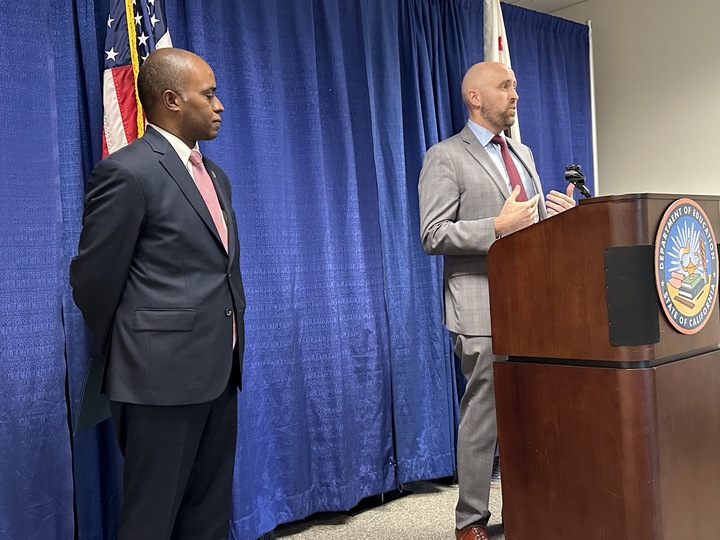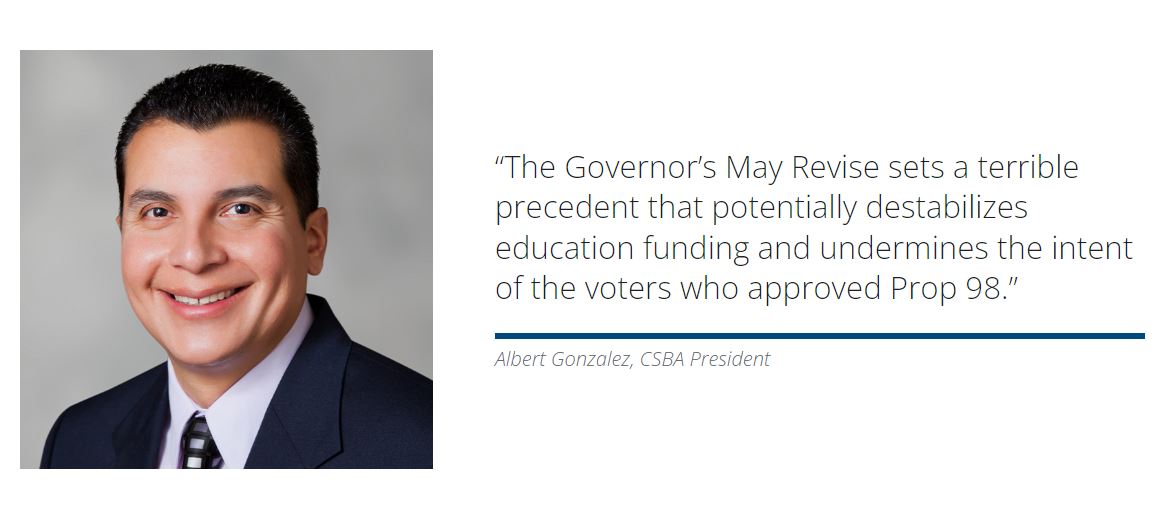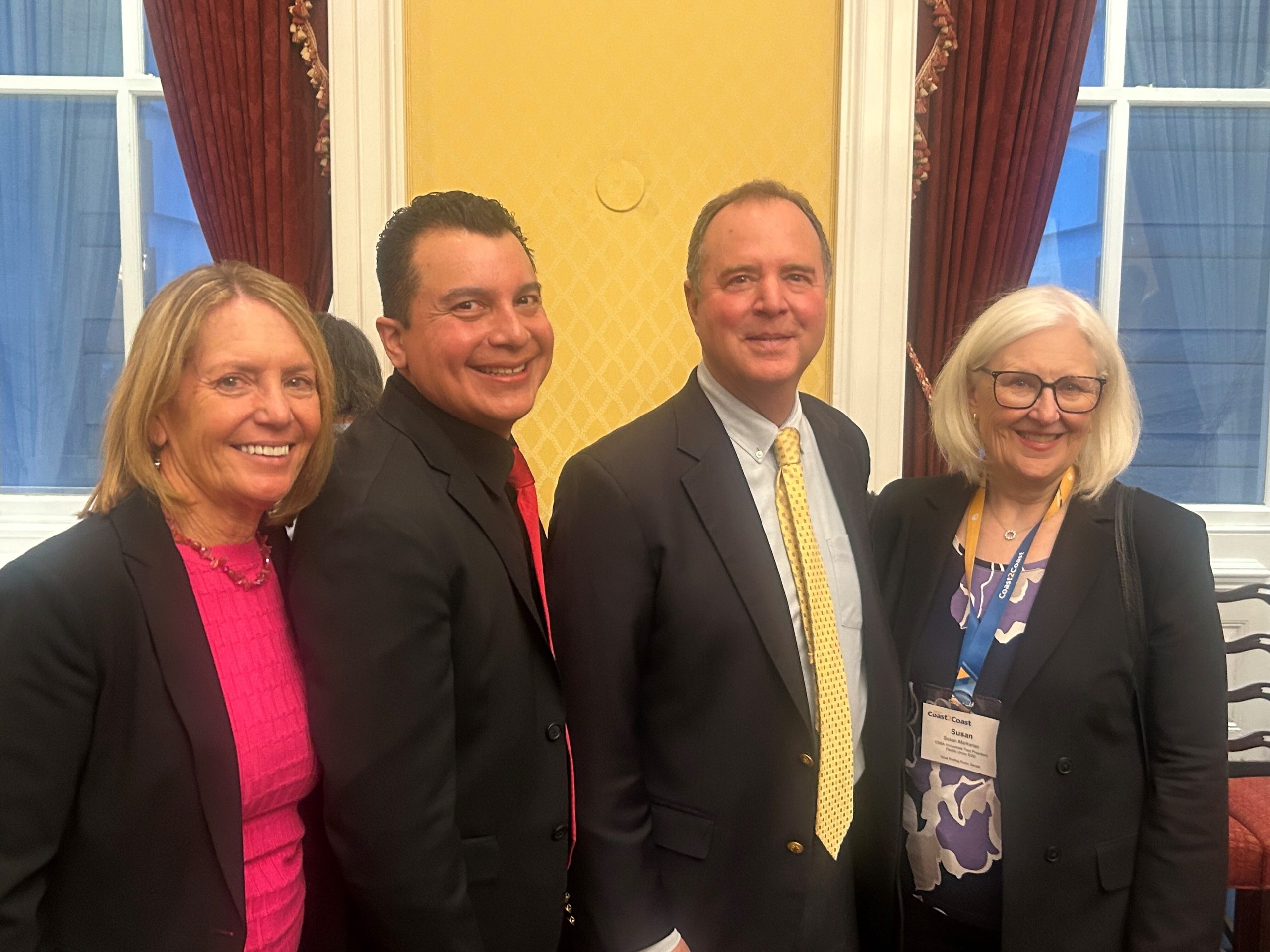CSBA hosted a virtual press event outlining the association’s budget advocacy and priorities on May 11. The event set the stage for the Governor’s May Budget Revision announcement and illustrated how high-leverage investments in the state budget can make a difference for students at the local level.
Education leaders from across the state shared how securing money in the budget for initiatives such as increasing the Local Control Funding Formula base funding, COVID attendance relief, pension relief, facilities funding — especially for the expansion to universal transitional kindergarten — and home-to-school transportation would benefit their local educational agencies and, most importantly, allow them to better support their students.
“Though it seems like we have weathered the worst of the pandemic, we will be experiencing its aftermath for some time to come,” said CSBA President Dr. Susan Heredia as she welcomed attendees. “Consequently, we must respond in a way that both recognizes the magnitude of the challenges before us, and we also must seize the opportunities we have to continue improving our schools for the students that we serve.”
LCFF base funding
CSBA is advocating for an increase to LCFF base funding beyond the statutorily required annual cost-of-living adjustment (COLA). The cornerstone of this year’s budget should be a historic investment in the LCFF. Local trustees and LEA leaders know best what their students and schools need to succeed. Base funding allows districts to target money to their specific needs.
As the lowest-funded school in Los Angeles County, Hermosa Beach City School District will be hurting even more if LCFF base funding isn’t raised — especially considering the district’s 12 percent enrollment drop in 2021–22, said Hermosa Beach City SD trustee Maggie Bove-LaMonica. “Currently at our funding level, we can’t even afford the state-required librarian. That comes to us through private funds and a loan from a neighboring district,” she said. “We desperately need the Governor to relook at how they fund schools and at how they fund the base specifically.”
Further south in San Diego County, Poway USD is also advocating for more base funding, according to trustee Darshana Patel. The district receives little supplemental and no concentration grant funding through the formula. “As we know, when we were ‘fully funded’ at the base, it still was insufficient,” she said. “California has one of the lowest-funded public school systems in the state, and we know that base funding was never sufficient to meet the needs of students.”
Patel further explained the district is using one-time COVID relief funds for programs, such as supporting student mental health and supplemental instruction. “But those are one-time dollars and if we want to have long-term solutions to the gaps that COVID has created, and for the challenges that COVID has created, we will need ongoing funding and we will need to make sure that comes from the base so that we can address the needs of all of our students.”
Pension relief
CSBA is requesting a $3.5 billion non-Proposition 98 General Fund payment on the behalf of LEAs to CalSTRS and the CalPERS Schools Pool, including $1.2 billion to sustain the employer contribution rates in the short-term and $2.3 billion to reduce the employers’ long-term unfunded liability for both systems.
“Employer contributions to pensions are crippling districts across California,” said Jurupa USD trustee Robert Garcia. “All of these increases impact our educational programs and in addition to other unfunded mandates, it puts further strain on our district and others.”
CSBA President Heredia noted that this crisis is not the fault of LEAs. “The explosive rate of pension increases and the burden this has placed on schools is a state-created crisis that demands a state-funded solution,” she said. “School districts did not set the rates, nor did we have a vote in the decision.”
COVID ADA relief
In recognition of the devastating impact COVID-19 variants had on attendance in the current year, CSBA is requesting the state allow schools to use the greater of a local educational agencies’ average daily attendance (ADA) percentage from 2019–20 and apply it to the LEA’s enrollment for the 2021–22 fiscal year.
Davis Joint USD has seen large numbers of absences this year, and trustee Thomas Adams expressed the need for COVID average daily attendance relief. “We made not return to normal, but if we are going to calculate ADA relief, it really needs to start with 2019–20,” he said. “In January with omicron, we had 959 absences student out in one month. That can’t really be a good year to predict future enrollment or attendance.”
Home-to-school transportation
CSBA is advocating for the state to provide the home-to-school transportation program with enough state funding to support 100 percent of approved costs, plus an annual COLA to account for increasing costs and expanded legislative policy goals.
While important to all LEAs, home-to-school transportation is essential in rural districts that serve students from a large geographic area, like West Sonoma County Union High School District, which consists of one traditional and one alternative high school. While the district has an LCFF allotment of about $19 million, the district spends more than $1 million on home-to-school transportation — and only receives half of that from state reimbursements.
“We desperately need the state to help us with Assembly Bill 2933, which will provide school districts with the funding and flexibility to best serve students without taking away from other programs,” said Jeanne Fernandes, West Sonoma County Union HSD trustee.
Del Norte USD is located in the northernmost part of the state and is a single-district county with one high school, covering an area of 1,200 square miles. Due to insufficient home-to-school transportation funding, the district has had to cut down and consolidate bus routes, causing some students to get on the bus at least 2.5 hours before the school begins.
“We have about 22 percent of our student body that takes the bus,” said district trustee and county office Superintendent Jeff Harris. “With the inability to fully fund home-to-school transportation, we’re also impacting what our students arrive to. Our transportation costs roughly $2 million dollars a year and the state funds $750,000 of that, which means the district is paying roughly 65 percent of transportation costs … about 6.5 percent of the entire district budget. When you equate that to programs for students, that is roughly 12 additional teacher-led classrooms, that is the ability to provide additional counseling services, that is the ability to upgrade school facilities.”
Transitional kindergarten facilities
CSBA is requesting additional non-Proposition 98 General Fund for LEAs to construct and house transitional kindergarten students and accommodate the new reduced class-size ratios and to amend the existing facilities program to allow LEAs to access 100 percent state funding until districts can pass local bonds for this construction activity.
TK facilities require specific facilities requirements related to young children. Patel of Poway USD noted that the funding provided thus far by the state has focused on staffing, not facilities. “Funding is needed to make sure schools have adequate facilities to house and serve these students,” she said. “Additional funding flexibility will be critical to ensuring our school districts can simply fulfill the state’s goals for TK expansion. Much more is needed than what [the Governor] has proposed. … We need the costs to come from the state because it’s a state mandate.”





